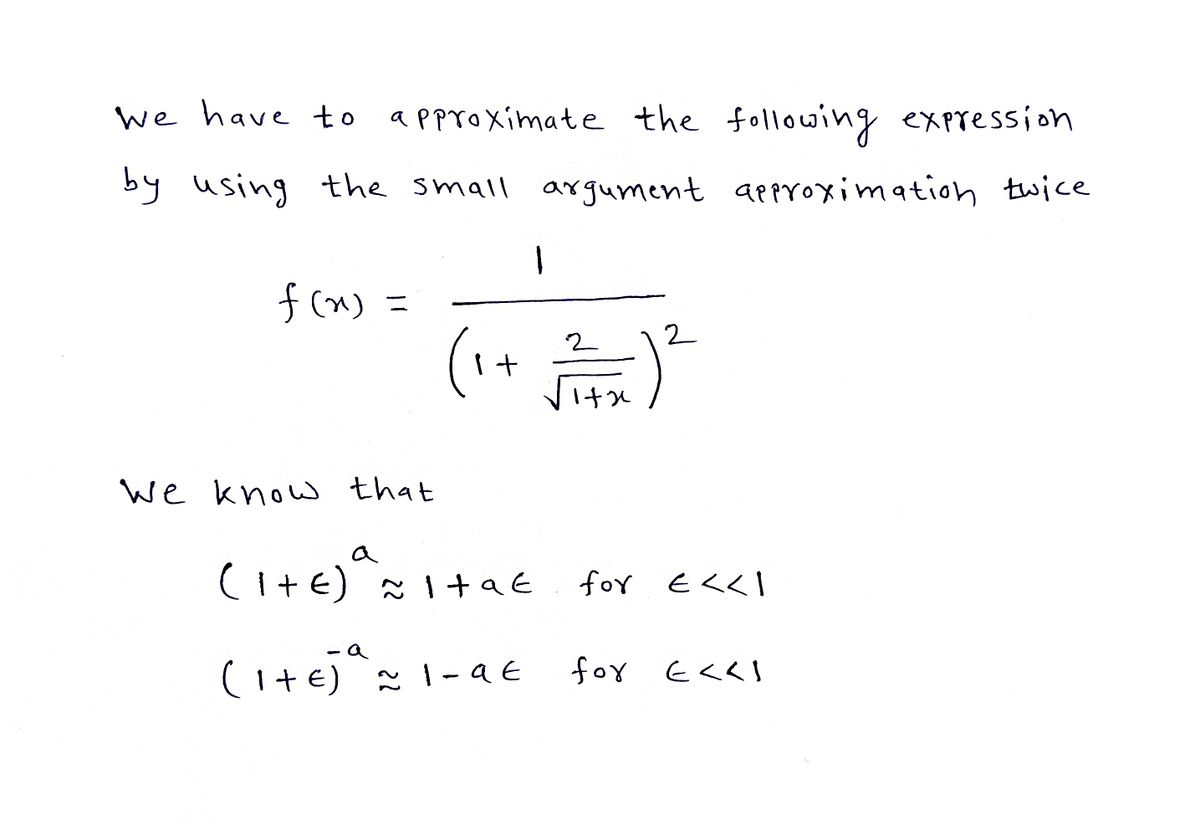part 4 of 4 One may approximate more complex ex- pressions through successive application of the small argument approximation. Approx- imate the following expression by using the small argument approximation twice. 1 f(x) = (1 + √²/₂)² ° ₁ - / - ( ¹ + + + + ) 1. 1+ 2. 2 ° 3 / 1 (1 + ²/²) 3. ° 4. / (1 - 13²) 9
part 4 of 4 One may approximate more complex ex- pressions through successive application of the small argument approximation. Approx- imate the following expression by using the small argument approximation twice. 1 f(x) = (1 + √²/₂)² ° ₁ - / - ( ¹ + + + + ) 1. 1+ 2. 2 ° 3 / 1 (1 + ²/²) 3. ° 4. / (1 - 13²) 9
Advanced Engineering Mathematics
10th Edition
ISBN:9780470458365
Author:Erwin Kreyszig
Publisher:Erwin Kreyszig
Chapter2: Second-order Linear Odes
Section: Chapter Questions
Problem 1RQ
Related questions
Question

Transcribed Image Text:As you work with Coulomb's law, you will
often find you'd like to approximate expres-
sions such as
1
(r+s)²
Fortunately, there is an approximation
method for this type of expression that is in-
credibly common and is used throughout the
sciences. We will call this method the small
argument approximation, and its statement is:
1
(r+s)²
for s<r.
(1 + €) ≈ 1+ a€ for € < 1,
1-ae for € < 1.
(1 + €)
Using this approximation method,
where s/r
€ < 1.
= (r+8)−² = 2(1+s/r)-²
≈(1 – 2s/r) for s <<r,
= € satisfies the condition that
For each of the exercises below, assume
x< 1 and apply the small argument approxi-
mation to determine the correct approximate
expression.

Transcribed Image Text:part 4 of 4
One may approximate more complex ex-
pressions through successive application of
the small argument approximation. Approx-
imate the following expression by using the
small argument approximation twice.
f(x)
=
1
(1 + √²/1
Vita)
° ^. // (¹ + 1/² )
1. 1+
9
2
° 2 / 3 (1 - ²/²)
2.
9
3.
(¹ + ²)
+ (¹ - / +)
¼
4.
Expert Solution
Step 1: Introduction

Step by step
Solved in 3 steps with 3 images

Recommended textbooks for you

Advanced Engineering Mathematics
Advanced Math
ISBN:
9780470458365
Author:
Erwin Kreyszig
Publisher:
Wiley, John & Sons, Incorporated

Numerical Methods for Engineers
Advanced Math
ISBN:
9780073397924
Author:
Steven C. Chapra Dr., Raymond P. Canale
Publisher:
McGraw-Hill Education

Introductory Mathematics for Engineering Applicat…
Advanced Math
ISBN:
9781118141809
Author:
Nathan Klingbeil
Publisher:
WILEY

Advanced Engineering Mathematics
Advanced Math
ISBN:
9780470458365
Author:
Erwin Kreyszig
Publisher:
Wiley, John & Sons, Incorporated

Numerical Methods for Engineers
Advanced Math
ISBN:
9780073397924
Author:
Steven C. Chapra Dr., Raymond P. Canale
Publisher:
McGraw-Hill Education

Introductory Mathematics for Engineering Applicat…
Advanced Math
ISBN:
9781118141809
Author:
Nathan Klingbeil
Publisher:
WILEY

Mathematics For Machine Technology
Advanced Math
ISBN:
9781337798310
Author:
Peterson, John.
Publisher:
Cengage Learning,

